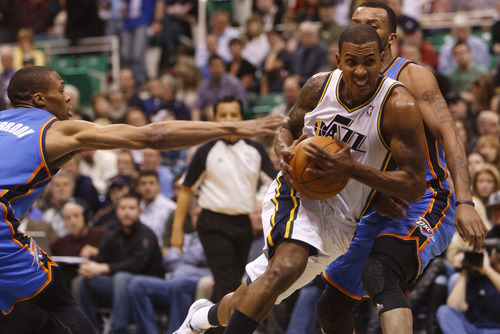This is an archived article that was published on sltrib.com in 2012, and information in the article may be outdated. It is provided only for personal research purposes and may not be reprinted.
The Utah Jazz's local television ratings this season are on par with last season's — and that's a pretty good thing.
Through the 82-game 2010-11 regular season, the local NBA franchise averaged a 5.5 local rating. Through the first 24 games of the lockout-shortened 66-game 2011-12 regular season, the Jazz averaged a 5.3 rating.
"We're pretty happy with those numbers," said Jeremy Castro, the team's director of broadcasting.
That's a dip of less than 4 percent, and given the public-relations disaster potential of the lockout, that's not bad. Particularly when the acrimonious battle between the owners and the players appeared to turn off so many fans.
Nationally, the numbers look even better. Through the first third of this season:
• TNT's NBA ratings are up 50 percent
• ESPN's NBA ratings are up 23 percent
• NBA TV viewership is up 66 percent.
(That NBA TV number needs some explaining. For one thing, the channel is averaging 391,000 viewers per game, so the addition of 150,000 viewers — a relatively modest figure nationally — looks huge as a percentage. For another, NBA TV is available in about 5 million more homes than it was a year ago.)
Overall, NBA games on regional cable networks are up 12 percent, and, overall, NBA games on local broadcast stations are up 36 percent.
So maybe the Jazz's 4 percent decline isn't such a good thing after all?
It's a little too early to draw that conclusion. And it's always dangerous to compare percentage increases and decreases because it's so often apples to oranges.
"We've had some pretty high notes," Castro said. "We're confident our numbers will remain good."
The Jazz have indeed shown that they can still draw a big TV crowd for a big game. The game against the Lakers on Feb. 4 topped out at a 10.8 rating for the last half hour of the Jazz win, with 100,000 viewers tuning in.
Pretty good, considering that ROOT Sports-Utah is in about 58 million fewer homes than NBA TV, which is averaging 391,000 viewers per game.
And the Jan. 28 win over Sacramento absolutely Jimmered the local ratings, averaging a whopping 9.0 over the entirety of the telecast.
(Hmmm ... would the ratings be better if the Jazz had drafted Jimmer Fredette? Or would the novelty wear off after a few games?)
It's also not fair to compare percentage gain or loss for the Jazz TV ratings because their numbers are better than most to begin with. For example, the Philadelphia 76ers are ecstatic because their local numbers are up 77 percent over last year's average.
That's not entirely unexpected. You would expect more viewers to watch when your team is in first place in its division.
But even with the big increase, Philadelphia is still averaging just a 2.8 household rating. Their highest-rated game this season, a 5.1 for a matchup with the Lakers, is below the Jazz's average this season. Sure, more households are tuning in on average in Philly (about 84,000) to see the Sixers than are tuning in to see the Jazz in Utah (about 49,000), but there are more than three times as many homes in the Philadelphia TV market.
TV ratings are a percentage of the available homes — so it's about as close to an apples-to-apples comparison as we can get.
And, comparatively, the Jazz are still doing very nicely.
Scott D. Pierce covers television for The Salt Lake Tribune. Email him at spierce@sltrib.com; follow him on Twitter @ScottDPierce; read his blog at sltrib.com/blogs/tv.



